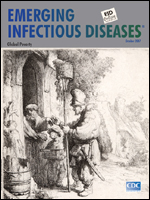CDC Features
Global Poverty, Economic Development, and Emerging Disease

Rembrandt van Rijn (1606–1669). The Rat Catcher (1632). Etching (13cm × 14cm). Courtesy of the "Sordid and Sacred Collection" of John Villarino
The article, presented in a shortened version below, is part of the journal's edition on Global Poverty and Human Development. Emerging Infectious Diseases, along with more than 230 other science journals, has dedicated its October 2007 issue to this topic. The effort was organized by the Council of Science Editors and roughly coincides with the UN General Assembly's International Day for the Eradication of Poverty.
A New Strain of Flu in Africa
It was January 2006 and, from Nigeria, reports were surfacing of chickens dying from a mysterious illness. Within days, a series of laboratories had confirmed the worst fears—that a new strain of influenza called H5N1 was infecting poultry. It was the first time the infection, which had been killing thousands of chickens in Asia, had been discovered in Africa.

Rats, Global Poverty, and Paying the Piper. Emerging Infectious Diseases, Volume 13, Number 10—October 2007
Already the disease had been documented to rarely pass from birds to humans, causing severe illness and deaths in Asia. Nigerian health officials sprang into action, tracking which farms were affected, working to decrease the chicken population in the affected areas and keeping watch for signs of human infections. Within a month, the virus had been found in four Nigerian states and was suspected of killing chickens in nine more states. More than 770,000 birds had either died of illness or been killed to help stop the spread of the disease.
International donors provided millions in aid money to help Nigeria cope with the infection among birds but, in a country lacking in the infrastructure to which the West is accustomed, it was difficult to get the aid to the local affected areas quickly. Within four months, the virus was affecting birds in 14 Nigerian states as well as areas in Niger and Cameroon that border Nigeria. The first human case in Nigeria was reported in January 2007.
Not surprisingly, an avian outbreak of that magnitude created a massive economic impact as well as taking away a much needed source of protein for Nigeria's 132 million people. Within two weeks of the initial discovery of the new flu virus, egg and chicken sales were down more than 80 percent. Farm workers suffered: 80 percent of those who worked on affected farms lost their jobs and, even on farms that were unaffected, 45 percent of workers were laid off. Many people stopped eating chicken, even in areas where no chickens were reported as ill.
Since then, the virus has continued to spread and is now in eight countries in Africa. Egypt has reported outbreaks in birds as well as 38 human cases and 15 deaths. No additional human cases have been found in Nigeria, but it's hard to tell if that's due to different practices to curtail the disease or simply that cases are occurring but not being reported.
Though primarily a bird virus, H5N1 has already shown it can make humans sick. As of this week, there have been 331 cases in 12 countries, leading to 202 deaths. So far, the virus doesn't easily pass from birds to humans, but what worries scientists is that it could make that leap, eventually causing a widespread international outbreak in a phenomenon called a pandemic. The worst recorded pandemic to date was in 1918, which killed an estimated 20-50 million people worldwide.
If the next pandemic is anything like the 1918 pandemic, sub-Saharan Africa would likely see more deaths than anywhere else in the world because of the country's poor nutrition, higher rates of other diseases like HIV/AIDS and limited access to healthcare. Africa is now working to prepare to both animal and human outbreaks but more is needed. An early warning system that would identify and assess clusters of flu-like illness that emerge is desperately needed. Meeting the challenge posed by this pandemic threat will require innovative thinking, determination, political will and a lot of money.
Africa itself poses a particular challenge in meeting a pandemic. Countries already struggle to address large outbreaks of HIV, tuberculosis and malaria, as well as high childhood death rates from pneumonia and diarrheal diseases. Although there are treatments and strategies to fight these diseases, African nations don't always have the money or infrastructure to fully use them. And now the focus on this new influenza is taking much needed attention and resources away from the already severe health challenges on the continent. Governments are finding it increasingly difficult to juggle both.
The world has changed dramatically since the 1918 pandemic. In today's world, where a virus can circle the globe in record time on international flights, the question becomes: whose problem is this new and deadly virus in Africa? And what should the world do about it?
More Information
- Preparedness for Highly Pathogenic Avian Influenza Pandemic in Africa, by Robert F. Breiman, Abdulsalami Nasidi, Mark A. Katz, M. Kariuki Njenga, and John Vertefeuille
- Emerging Infectious Diseases journal, Table of Contents
- Avian Influenza
- Global Theme Issue, October 2007*, Council of Science Editors
Page last updated: October 22, 2007
Content source: Coordinating Center for Infectious Diseases
Content owner: National Center for Health Marketing
URL for this page: www.cdc.gov/Features/AvianFluAfrica/
*Links to non-federal organizations are provided solely as a service to our users. These links do not constitute an endorsement of these organizations or their programs by CDC or the federal government, and none should be inferred. CDC is not responsible for the content of the individual organization Web pages found at these links.


